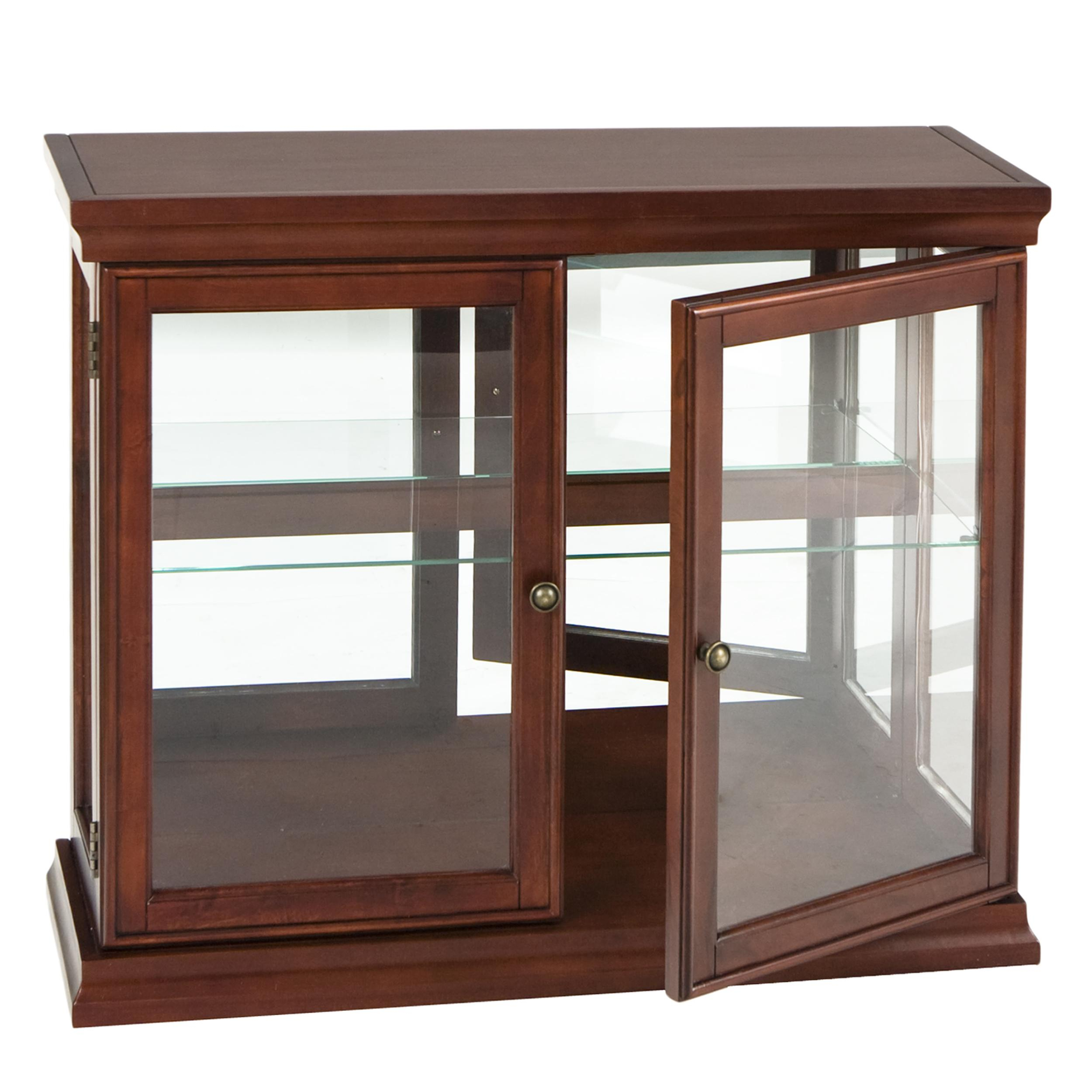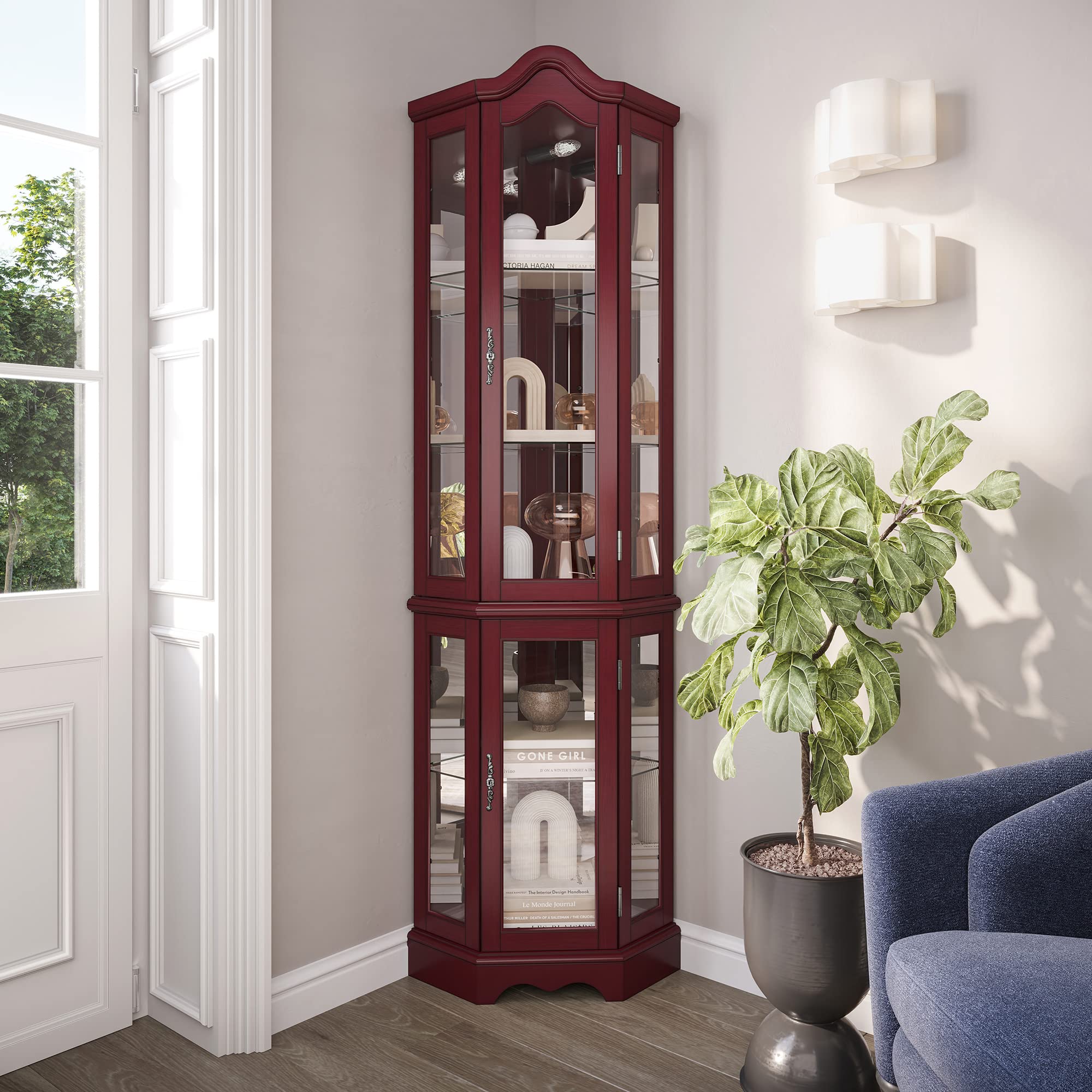Curved Glass Curio Cabinet Design and Features

The allure of a curved glass curio cabinet lies in its ability to transform a simple display into a captivating visual experience. The graceful curves of the glass create a sense of movement and depth, adding a touch of elegance and sophistication to any space. This unique design element not only enhances the aesthetics of the cabinet but also provides a distinct advantage in showcasing your prized possessions.
Types of Curved Glass
The choice of curved glass for a curio cabinet depends on the desired aesthetic and functional properties. Tempered glass, known for its exceptional strength and durability, is a popular choice for curved glass curio cabinets. Its resistance to impact and thermal shock makes it ideal for handling heavy objects and resisting accidental damage. Laminated glass, another common option, consists of two or more layers of glass bonded together with a layer of plastic. This construction provides increased safety, as the plastic layer helps to hold the glass fragments together in case of breakage.
Curved Glass Designs
Curved glass can be incorporated into a variety of curio cabinet designs, adding a touch of uniqueness to each. Full-length curved glass doors create a dramatic and eye-catching entrance to the cabinet, allowing for a clear and unobstructed view of the displayed items. Arched tops, with their graceful curves, add a touch of classical elegance to the design, reminiscent of antique furniture. Rounded corners, subtly blending into the overall design, contribute to a more modern and sleek aesthetic.
Display Enhancement
Curved glass enhances the display of collectibles and artifacts by creating a captivating visual experience. The curved surface refracts light, casting a unique and mesmerizing glow on the objects within the cabinet. This effect adds depth and dimension to the display, highlighting the intricate details and textures of each piece. The curved glass also minimizes reflections, allowing for a clear and unobstructed view of the objects from multiple angles.
Structural Considerations
Designing a curved glass curio cabinet requires careful consideration of structural integrity. The curved glass panels need to be securely supported to withstand the weight of the objects and resist potential damage. The frame of the cabinet should be robust and well-designed to accommodate the curved glass panels. Special attention should be paid to the hinges and locks, ensuring they are durable and reliable.
Materials and Construction

The construction of a curved glass curio cabinet involves a careful selection of materials and meticulous craftsmanship to ensure both structural integrity and aesthetic appeal. From the choice of wood to the precision of joinery and the artistry of glass shaping, each element plays a vital role in creating a unique and enduring piece of furniture.
Wood Types and Durability
The frame of a curio cabinet provides the foundation for its structure and style. Various wood types, each with its distinct characteristics, are commonly used for this purpose.
- Oak: Renowned for its durability and strength, oak is a popular choice for curio cabinet frames. Its tight grain pattern and rich color create a classic and timeless aesthetic. Its hardness makes it resistant to scratches and dents, ensuring the cabinet’s longevity.
- Cherry: Cherry wood is prized for its warm reddish-brown hue that deepens with age. It is known for its beautiful grain patterns and its ability to accept stains and finishes well. However, cherry is relatively softer than oak and may be more susceptible to scratches and dents.
- Mahogany: Mahogany is a luxurious wood known for its deep reddish-brown color and beautiful grain patterns. Its strength and durability make it a suitable choice for furniture frames. Its rich color and distinctive grain add a touch of elegance and sophistication to any room.
The choice of wood depends on the desired aesthetic, budget, and the level of durability required.
Joinery Techniques, Curved glass curio cabinet
The strength and stability of a curio cabinet frame rely heavily on the joinery techniques used to connect its various components.
- Dovetail Joints: Dovetail joints are known for their strength and intricate appearance. They are created by interlacing the edges of two pieces of wood, forming a series of interlocking “tails” and “pins”. This interlocking design prevents the joint from pulling apart, making it ideal for areas that experience stress, such as the corners of a cabinet frame.
- Mortise and Tenon Joints: Mortise and tenon joints involve creating a rectangular hole (mortise) in one piece of wood and a corresponding projection (tenon) on another piece. The tenon is then inserted into the mortise, creating a strong and secure joint. This technique is commonly used for joining the legs, rails, and stiles of a curio cabinet frame.
These techniques ensure the structural integrity of the cabinet and prevent it from warping or becoming unstable over time.
Glass Cutting and Shaping
The curved glass panels are a defining feature of a curved glass curio cabinet. The process of cutting and shaping these panels requires specialized skills and equipment.
- Cutting: Curved glass is typically cut using a specialized glass cutter and a template. The glass cutter scores the surface of the glass, creating a precise line that can be easily broken along the scored line.
- Shaping: After cutting, the glass is heated and bent to the desired curve using a specialized bending furnace. This process requires careful control of temperature and time to prevent the glass from cracking or breaking.
The curved glass panels not only add visual appeal but also contribute to the cabinet’s unique character.
Hardware and Functionality
Hardware plays a crucial role in the functionality and aesthetics of a curio cabinet.
- Hinges: Hinges allow the doors of the cabinet to open and close smoothly. Different types of hinges, such as concealed hinges or decorative hinges, are available, each offering a unique style and functionality.
- Locks: Locks provide security for the cabinet, protecting its contents from unauthorized access. Various lock types, including key locks, combination locks, and magnetic locks, can be used depending on the desired level of security.
- Shelves: Shelves provide storage space for the cabinet’s contents. Adjustable shelves offer flexibility in organizing different sized items.
The choice of hardware should be carefully considered to ensure the cabinet’s functionality and aesthetic appeal.
Finishing Techniques
The final finish of a curio cabinet significantly impacts its appearance and durability.
- Staining: Staining enhances the natural beauty of the wood by adding color and depth. Different stains are available, offering a wide range of colors and finishes.
- Varnishing: Varnishing provides a protective layer that shields the wood from moisture, scratches, and UV damage. It also enhances the sheen and luster of the wood.
- Painting: Painting allows for greater creative freedom in customizing the cabinet’s appearance. Various paint colors and finishes can be used to create a unique and personalized look.
The chosen finishing technique should complement the cabinet’s overall design and style.
Functionality and Display

A curved glass curio cabinet is more than just a beautiful piece of furniture; it’s a functional display space designed to showcase your treasured collections while protecting them from dust, damage, and the elements. To maximize its functionality and enhance the display of your prized possessions, consider these essential aspects.
Lighting Options for Curio Cabinets
Lighting plays a crucial role in highlighting the beauty of your collectibles and creating an inviting ambiance. Here’s a table comparing different lighting options for curio cabinets, outlining their advantages and disadvantages:
| Lighting Type | Advantages | Disadvantages |
|---|---|---|
| LED | Energy-efficient, long lifespan, cool operation, various color temperatures, dimmable | Can be more expensive upfront, some LED strips may be difficult to install |
| Halogen | Bright and warm light, affordable, easy to install | High energy consumption, generates heat, shorter lifespan compared to LED |
| Incandescent | Warm and inviting light, affordable, easy to install | High energy consumption, generates heat, short lifespan, not as bright as halogen |
Creating an Effective Display Arrangement
Arranging your collectibles in a curved glass curio cabinet requires careful consideration of size, shape, and lighting to create a visually appealing and cohesive display.
* Size and Shape: Group similar-sized items together to avoid overcrowding and maintain a balanced visual flow. Use varying heights and depths to create visual interest and prevent monotony.
* Lighting: Strategically place lighting to highlight key features and minimize shadows. Consider using spotlights to illuminate individual pieces or backlighting to create a dramatic effect.
* Color and Texture: Arrange items with complementary colors and textures to create a harmonious display. Utilize contrasting colors and textures to add visual interest and highlight individual pieces.
Importance of Ventilation and Humidity Control
Preserving the value and integrity of your collectibles requires proper ventilation and humidity control.
* Ventilation: Adequate ventilation prevents moisture buildup and mold growth, which can damage delicate items. Ensure the cabinet has proper ventilation openings or consider using a small fan to circulate air.
* Humidity Control: Extreme humidity fluctuations can cause warping, cracking, and discoloration of collectibles. Use a humidity control device, such as a desiccant pack or a humidifier, to maintain a stable humidity level.
Cleaning and Maintenance Tips
Regular cleaning and maintenance are crucial for preserving the longevity of your curio cabinet and protecting its contents.
* Dust Regularly: Dust the cabinet interior and exterior regularly to prevent dust buildup, which can obscure the display and damage delicate items. Use a soft, microfiber cloth or a feather duster.
* Clean Glass Surfaces: Clean the curved glass panels with a glass cleaner and a microfiber cloth. Avoid using abrasive cleaners or paper towels, which can scratch the glass.
* Inspect and Repair: Regularly inspect the cabinet for any signs of damage, such as cracks, scratches, or loose hardware. Address any issues promptly to prevent further damage.
Safety Precautions for Handling Fragile Objects
Handling fragile objects requires extra care to prevent accidents and damage.
* Wear Gloves: Wear soft, cotton gloves when handling delicate items to prevent fingerprints and oils from transferring onto the surfaces.
* Use Lifting Aids: Use lifting aids, such as a padded lifting strap or a dolly, to move heavy or bulky items safely.
* Secure Placement: Securely place items in the cabinet, using non-abrasive materials like felt pads or foam to prevent scratching or slipping.
* Avoid Overcrowding: Avoid overcrowding the cabinet to prevent items from bumping into each other and potentially getting damaged.
A curved glass curio cabinet is a statement piece that adds a touch of elegance to any room. The sleek curves and reflective surface create a sense of depth and intrigue, making it a perfect place to showcase your prized possessions.
To really make the cabinet pop, consider pairing it with a kitchen featuring black matte appliances with white cabinets , creating a striking contrast that highlights the cabinet’s unique design. The combination of the cabinet’s vintage charm and the modern aesthetic of the kitchen will give your home a truly sophisticated look.
A curved glass curio cabinet can be a stunning focal point in any room, showcasing your prized possessions with elegance. For a kitchen, consider pairing it with the classic look of white kitchen cabinets with black appliances pictures , creating a stylish contrast.
The cabinet’s curves will add a touch of modern flair to the traditional kitchen design, making it a conversation starter.
